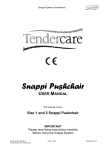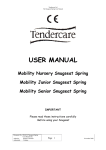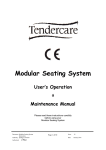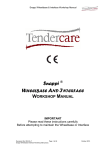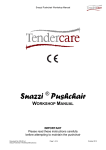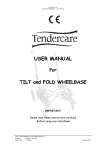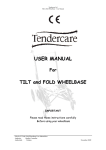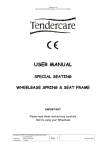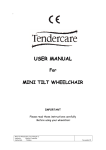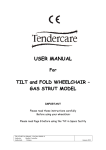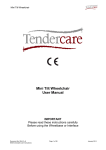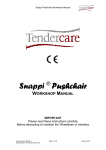Download Snugseat Snappi
Transcript
Snugseat Snappi User Manual Snugseat Snappi USER MANUAL This manual covers: Nursery Snugseat on Size 1 Chassis Junior Snugseat on Size 2 Chassis IMPORTANT Please read these instructions carefully Before using the Wheelbase or Snug Seat Document No: 053-03 v5 Snugseat Snappi User Manual.doc Page 1 of 37 September 2010 Snugseat Snappi User Manual Fig 0.1 Snugseat on Snappi Wheelbase (Nursery seat on size 1 chassis shown) Fig 0.2 Wheelbase (size 1 shown) Document No: 053-03 v5 Snugseat Snappi User Manual.doc Page 2 of 37 September 2010 Snugseat Snappi User Manual Fig 0.3 Wheelbase Folded (size 1 shown) Fig 0.4 Snugseat Seat Unit (Nursery shown) Document No: 053-03 v5 Snugseat Snappi User Manual.doc Page 3 of 37 September 2010 Snugseat Snappi User Manual Item Description Page 1 Who to contact if you have difficulty 2 Introduction 6–7 3 Unpacking 7–8 4 Preparing the wheelbase for use 4.1.1 Unfolding the frame (Original Locks) 4.1.2 Unfolding the frame (Spring Loaded Locks) 4.2 Brakes 4.3 Fitting seat to the chassis and setting safety catch 4.4 Tilt in space 4.5 Fitting footrest to seat 4.6 Fitting pommel to seat 8 8-9 10 11 12– 14 15 16 17 5 Setting up the seat unit 5.1 Fitting support pads 5.2 Setting up the patterned cover 5.3 Adjusting the harness 5.4 To lock and release the harness 5.5 Final checks 18 19 – 21 21 – 22 23 23 23 6 Accessories 6.1 Shopping Basket 6.2 Equipment Carrying Tray 6.3 Sun Canopy 6.4 Frame Padding 6.5 Rain Cover 6.6 Playtray 24 24 25 26– 27 27 28 29 - 30 7 User instructions 7.1 Getting into the Snugseat 7.2 Setting out of the Snugseat 8 Attendant Pushing 8.1 Pushing 8.2 Brakes 8.3 Comfort 8.4 Lifting and general safety 9 Cleaning Document No: 053-03 v5 Snugseat Snappi User Manual.doc 6 31 31 31 31 31 – 32 32 32 33 33 Page 4 of 37 September 2010 Snugseat Snappi User Manual 9.1 Chassis and seat shell 9.2 Patterned covers and tummy pad 9.3 Modular foam pads 9.4 5-Point harness 33 33 33 33 10 Maintenance 10.1 Routine maintenance 10.2 Six – monthly maintenance 11 Oxygen Cylinder 35 12 Warranty 35 13 Transporting the Snugseat Snappi 13.1 Preparing wheelbase for transport 13.2 Attaching wheelbase to vehicle 14 Repairs Document No: 053-03 v5 Snugseat Snappi User Manual.doc 33 33 – 34 34 36 36 36 – 37 37 Page 5 of 37 September 2010 Snugseat Snappi User Manual 1: Who to contact in difficulty Tendercare Ltd. PO BOX 3091, Littlehampton, BN16 2WF Tel: (01903) 726161 Fax: (01903) 734083 Email: [email protected] Web: www.tendercareltd.com 2: Introduction The Snugseat postural control seating system is designed to enhance the sitting of disabled children who have postural instability with minimal skeletal deformities. The Wheelbase is made of a strong and lightweight aluminium alloy, minimising weight and providing a very rugged frame. The wheelbase provides a tilt in space facility and has 2 fixed rear wheels and 2 castor wheels at the front for easy steering. The wheelbase comes in 2 sizes, size 1 and size 2 and can accommodate nursery or junior snug seats respectively. The seat unit is available in two sizes, Nursery and Junior. The seat is supplied with an attractive cover and modular pad inserts to meet the needs of a wide range of users. The seat has five-point harness, pommel and footrest. The seat can be quickly fitted and removed from the buggy, which can be folded for transport. The complete system has passed impact tests and has been designed for use as a vehicle seat when restrained in accordance with this manual (see section 12). The following accessories for use with the Snugseat Snappi are available from Tendercare Ltd. Carrying tray, Shopping basket, Rain-hood, Sun canopy, Snug-toes, Standard Headrest, Occipital Roll Headrest and Extra Recess Headrest. These instructions apply to all sizes. SEAT SIZE – mm MAX OCCUPANT WEIGHT WIDTH DEPTH HEIGHT Nursery 35 kg 300 250 550 Junior 40 kg 340 320 610 MODEL IMPORTANT: Maximum weight includes the occupant and all accessories. Document No: 053-03 v5 Snugseat Snappi User Manual.doc Page 6 of 37 September 2010 Snugseat Snappi User Manual Dimensions (mm) A B C Snugseat Snappi Open Size 1 Size 2 950 1065 571 684 1000 1055 All sizes and weights are given as a guide. Tendercare ltd reserves the right to amend specifications at any time as part of their product development programme. 3: Unpacking The wheelbase is delivered in a cardboard carton. This measures 680mm wide x 480mm deep x 1030mm high and weighs approximately 15Kg. The Snugseat seat unit, upholstery and modular padding are delivered in a cardboard carton of approximate weight 13kg and size 480 mm wide x 530 mm deep x 800 mm high. WARNING: The transit carton is quite bulky so moving and unpacking must be done with care. Observe all lifting and handling regulations. Stand the carton upright making sure it is supported and cannot fall over. Open the carton and remove any packages or packing, which could obstruct the removal of the wheelbase. Remove the wheelbase or seat and any other packages, which are still in the carton. Document No: 053-03 v5 Snugseat Snappi User Manual.doc Page 7 of 37 September 2010 Snugseat Snappi User Manual Check you have the following items: Item Component Number 1. 2. 3. 4. 5. 6. 7. 8. Buggy Seat Unit 5 point harness fitted to seat unit Footrest Pommel Bag containing seat cover, tummy pad and pommel cover Bag containing modular pads and wedges User Manual 1 1 1 1 1 1 1 1 Yes No IMPORTANT: If any items are damaged or missing, then please contact Tendercare, preferably by email at [email protected] or alternatively please call us on (01903) 726161 within 36 hours of delivery. Remove the upholstery and modular pads from their plastic bags and any protective packaging from the frame. After unpacking and checking you have all components and they are in good condition dispose of the packaging at your local recycling centre. Alternatively retain and reuse. 4: Preparing the wheelbase for use WARNING: When opening or folding the wheelbase, ensure that you hold the frame so that you avoid any danger of catching your fingers in moving parts. Keep children clear of the wheelbase during opening and folding. 4.1.1 Unfolding the Frame (original locks) Fig 4.1.1.1 Standing at back of the wheelbase, place your foot on the rear cross member X (see right) and lift handle labelled Y as far as it will move. This will open the frame. Document No: 053-03 v5 Snugseat Snappi User Manual.doc Page 8 of 37 September 2010 Snugseat Snappi User Manual Fig 4.1.1.2 Next locate the 2 plastic locking sliders. These will be stowed in the “open” position and are held in place by 2 small spring clips. Fig 4.1.1.3 Press the 2 silver “Spring pins” in and slide the 2 locking pieces down over the lower tube sections. Fig 4.1.1.4 The pins will spring through the holes in the sliders and hold them in place (see left). WARNING: If the locking sliders are not in the correct position, or the spring pins do not protrude thereby allowing the locking clips to move back up the frame, then the frame may collapse in use. Folding the wheelbase: To unlock the frame and fold the wheelbase, reverse the above instructions. Document No: 053-03 v5 Snugseat Snappi User Manual.doc Page 9 of 37 September 2010 Snugseat Snappi User Manual 4.1.2 Unfolding the Frame (Spring loaded locks) Fig 4.1.2.1 Standing at back of the wheelbase, place your foot on the rear cross member X (see right) and lift handle labelled Y as far as it will move. This will open the frame. Fig 4.1.2.2 Once the frame is almost open, the 2 plastic frame locks will engage with the angled sections of the lower frame. Continue to unfold the frame; this will force the locks up the tubes. There will be some resistance, as you will be working against the locking springs. Fig 4.1.2.3 Once fully open, the frame locks will snap shut over the front frame, securing the frame in the open position. Always check that both locks are fully closed. In the locked position the guide bolt ‘B’ will be sat in the top of the slot ‘A’ on the side of the slider as shown (see right). If there is any slot visible above the guide bolt, push the lock down by hand until it will not move any further. Fig 4.1.2.4 To fold the frame: Standing beside the frame, pull up the 2 locking sliders as shown (see left). Whilst holding the locks open, push down with your arm on the upper frame or push handle, so that the frame starts to fold. Release the locking sliders, and fold down the frame by moving the push handle down as far as it will move. IMPORTANT: Always check that BOTH frame locks are fully closed before using the frame. If they are not properly engaged, the frame could collapse during use. Document No: 053-03 v5 Snugseat Snappi User Manual.doc Page 10 of 37 September 2010 Snugseat Snappi User Manual 4.2 Brakes Fig 4.2.1 To apply the brake, put your foot on the top of brake bar (labelled X) and push down as shown. The brake will flip down onto the wheels and lock them. Fig 4.2.2 To release the break, simply hook your foot between the middle raised portion of the brake bar, and the frame cross bar. Then, lift the break bar with your foot until it flips back and stops against the brake stop pins. You may find it easier to use your hand instead of your foot to release the brake. WARNING: The break mechanism is spring loaded so care must be taken when operating it. Always put the brake on when placing the child in or taking them out of the seat. Do not leave the pushchair on a slope, even with the brake on. Always ensure that the pushchair is on level ground to prevent risk of injury to the occupant. Do not leave the brake on when the pushchair is not in use as this will damage the rear wheels. Document No: 053-03 v5 Snugseat Snappi User Manual.doc Page 11 of 37 September 2010 Snugseat Snappi User Manual 4.3 Fitting the seat to the chassis The seat is fitted with a Snappi Interface system, and includes a 2-stage latch that comprises a main latch and a second safety catch that prevents accidental release of the seat from the chassis. The safety catch must be correctly set before the main catch can be operated: How to operate the safety catch: Fig 4.3.1 The safety catch clip is located under the front right corner of the seat near to the release lever. Definition of components: X: Pull handle Y: Locking Pin Safety Catch Locked Fig 4.3.2 To release it, pull the handle “X”, and turn it 90 degrees so that the pin “Y” is fully retracted. To lock it, pull “X” and turn 90 degrees in the opposite direction, so that pin “Y” is fully protruded and sits behind the interface main catch “B” (see fig 4.3.3 on next page). Safety Catch unlocked Important: When fitting or removing the seat, the carer / parent must first ensure that the safety catch pin is set in the “unlocked” position. It will not be possible to fit or remove the seat if the latch is “locked”, and attempting to do so may cause damage to the chassis or the seat. Once the seat has been fitted, the carer / parent must always lock the safety catch. Note: A warning label is positioned on the front right hand portion of the tilt frame on the chassis, to remind carers to lock the safety catch. Document No: 053-03 v5 Snugseat Snappi User Manual.doc Page 12 of 37 September 2010 Snugseat Snappi User Manual To fit the seat to the frame: Fig 4.3.3 Definition of interface mounting points: A: Interface Rear Hooks B: Interface Main Clips C: Interface Secondary Latch Fig 4.3.4 D: Interface Release Handle E: Frame interface rear bushings F: Frame interface front bushings Fig 4.3.5 Ensure that the secondary latch “C” has been unlocked (see instructions on previous page). Holding the seat as shown, tilt it back and locate the 2 rear hooks “A” on the back of the interface, over the stainless steel bushings on the back of the frame interface. Fig 4.3.6 Next, rotate the seat forward and down so that the main clips “B” snap over the front stainless steel bushes on the frame interface. Note that due to the design of the frame interface, it is not possible to fit the seat backwards. If fitted the wrong way around the clips will not close and it will not sit down into the frame. Document No: 053-03 v5 Snugseat Snappi User Manual.doc Page 13 of 37 September 2010 Snugseat Snappi User Manual Fig 4.3.7 Next, push down firmly on the release lever “D” to ensure that the clips are fully closed. Note the lever is positioned under the front right corner of the seat (see right). Set the secondary latch “C” to the “Locked” position (so that the pin sits behind the interface clip). Fig 4.3.8 To remove the seat, first unlock the secondary catch “C” as detailed on page 11. Lift the release lever “D” up, whilst holding the top of the seat with your other hand. This will open the main clips “B”, rotate the seat back so that the main clips are clear from the frame, and lift the seat away from the buggy. IMPORTANT: Always ensure that the seat interface clips are fully closed. To test this, press down on the release lever when fitted and make sure the clips will not move (see fig 4.3.5). Always lock the secondary latch before using the buggy. Always unlock the secondary latch before fitting or removing the seat. Attempting to fit or remove the seat with the latch locked could cause damage to the seat, interface or chassis. Do not attempt to fit the seat backwards. It will not lock in a rearward facing position. The seat interface system is spring loaded, so ensure your fingers are clear of the clips when fitting or removing. Document No: 053-03 v5 Snugseat Snappi User Manual.doc Page 14 of 37 September 2010 Snugseat Snappi User Manual 4.4 Using the Tilt in Space facility Fig 4.4.1 To operate the tilt in space mechanism, place your hand over the push handle adjustor, and lift the lever ‘L’ (see left) as shown. Fig 4.4.2 This will open the gas strut and tilt the seat. Note; The speed of tilt can be controlled by varying the pressure applied at lever L. Use your other hand to support seat as it tilts. Fig 4.4.3 To reset the tilt mechanism, hold down lever L and push down firmly on the front of the seat as shown (see left). Once in the desired position, release lever L. For a 90degree position, move the seat so the gas strut is fully closed and it will not move any further before releasing the tilt lever. IMPORTANT: Always ensure any harness provided for the child is used and correctly adjusted before reclining or returning the seat to a more upright position. Always support the seat when tilting, as the gas springs can be quick to operate. If the seat is not supported, is may move swiftly and could cause the occupant distress. Document No: 053-03 v5 Snugseat Snappi User Manual.doc Page 15 of 37 September 2010 Snugseat Snappi User Manual 4.5 Fitting footrest to seat Fig 4.5.1 Pass the two chrome bars “A” of the footrest through the buttonhole in the front of the seat cover and insert them into the corresponding holes in the seat frame. (See picture opposite) Lock footrest in place by tightening (turn clockwise) the two thumbscrews “B” under the seat frame. NOTE: - The seat cover is not shown for clarity. Fig 4.5.2 To adjust the height of the footrest, loosen the two screws “C” in the centre of the footrest. (See picture opposite). Turn the screws anticlockwise using a flat bladed screwdriver whilst holding the nut at the back of the footrest with a 10mm spanner. Move the footrest to the desired height and retighten both screws (turn clockwise). The foot straps “D” are held with Velcro. To fit and adjust simply pull them apart place around the feet and push together. Document No: 053-03 v5 Snugseat Snappi User Manual.doc Page 16 of 37 September 2010 Snugseat Snappi User Manual 4.6 Fitting pommel to seat The pommel is mounted on an adjustable steel frame so that the height and depth can be adjusted using thumbscrews. (See picture below). To fit the pommel, pass the chrome bar with a slot in it through the buttonhole in the front of the seat cover. Then looking under the front of the seat, remove the thumbscrew shown in the picture above. Insert the slotted bar of the pommel into the mounting slot then insert and tighten the thumbscrew. NOTE: - The seat cover is not shown for clarity. To adjust the depth, loosen the thumbscrew under the seat and move the pommel in or out until it is in the desired position then retighten the screw. To adjust height, loosen the thumbscrew on the front of the pommel support tube. Move the pommel to the desired height then retighten the screw making sure that the screw fits into one of the indentations in the pommel support bar. IMPORTANT: - DO NOT use the pommel as a stop to prevent the child sliding forwards. Document No: 053-03 v5 Snugseat Snappi User Manual.doc Page 17 of 37 September 2010 Snugseat Snappi User Manual 5.0 Setting up the seat unit When setting up the seat unit always ensure the following is done: • Always consult your Therapist or Rehabilitation Engineer for advice. • Ensure that the child is relaxed and happy and if possible in an environment in which they are familiar. • If possible, sit the child on a plinth to take the measurements listed below: Measurement Symbol Pelvic Width P.W. Seat Depth S.D. Lateral Trunk Support (Under armpit to seat) LTS Footrest Height F.H. Millimetres Inches Note: you can now position the pads according to the child’s dimensions Document No: 053-03 v5 Snugseat Snappi User Manual.doc Page 18 of 37 September 2010 Snugseat Snappi User Manual 5.1 Fitting support pads For an example of pad positioning see fig 5.1.1. Select the correct seat cushion and Velcro it into the seat shell, so that the front of the cushion is flush with the front edge of the shell. The flat cushion gives a neutral hip angle and the ramped cushion will achieve a flexed hip angle. Select the combination of back pads required to give the required set seat depth (S.D.) and Velcro in position. Using the pelvic width (P.W.) and lateral trunk support (L.T.S.) dimensions position the pads in the shell. Adjust footplate to the required height (F.H.) See section 4.5. Check the following: • The pelvis is in the mid line position and not anteriorly rotated (i.e. not sacral seating) • The pelvic lateral supports provide enough support without being over tight. • The lateral supports are not too tight under the arm pits • The hips are about the mid line • The footrest is adjusted to the correct height • The abduction is satisfactory. If more abduction is required fit a pommel. (See section 4.6). IMPORTANT: - DO NOT use the pommel as a stop to prevent the child sliding forwards. Document No: 053-03 v5 Snugseat Snappi User Manual.doc Page 19 of 37 September 2010 Snugseat Snappi User Manual Fig 5.1.1: Snug Seat Pads and Support Elements Document No: 053-03 v5 Snugseat Snappi User Manual.doc Page 20 of 37 September 2010 Snugseat Snappi User Manual At the required Lumber Support (L.S.) position on the backrest pad, Velcro two wedge shaped pads with the narrow edge towards the middle of the seat. Ensure that the lumber pad has promoted a symmetrical lumber curve and not simply displaced the pelvis forward. At the required Head Support (H.S.) positions, Velcro the head supports to the back pad to help maintain head stability. The small flat pads are used for lateral support and the wedge pads for posterior support. The thickness and position of the pads will determine the support of the head and stability in a forward direction. If required, attach the pommel to seat and adjust for correct position. Note: -Always remove pommel before placing child in the seat. Position the child in the seat and assess the child's posture. If the posture is correct remove the child. Take a photograph or draw a sketch of the pad positions. The child’s carers should retain one copy for their reference and a further copy should be placed in the child’s file. The child's posture in the seat will need to be reassessed on a regular basis, consult your paediatric therapist with regard to how often this should be. 5.2 Setting up the cover The 5-point harness is fitted to the seat cover before the seat cover is fitted to the Snugseat. Fig 5.2.1: 5-point harness Tip. The harness length adjuster always goes over the user’s thighs, NEVER the shoulders. Document No: 053-03 v5 Snugseat Snappi User Manual.doc Page 21 of 37 September 2010 Snugseat Snappi User Manual Fit the harness to the seat cover by inserting all straps from the patterned side of the cover. When passing the buckle through the slots in the harness always twist the buckle so that the smallest side passes through the slot first. (See fig 5.2.2, right). Insert both shoulder straps and black buckles through the nearest slot that is above the child’s shoulder height. Fig 5.2.2 Insert the pelvic straps and buckles through the slots in the seat section, which are at the rear and side of the seat. Always make sure that the harness adjustment mechanism remains on the patterned side of the cover. To insert the groin strap first remove the buckle. Note how the webbing is threaded through the buckle. (See fig 5.2.3, next page). Thread the groin strap through the slots in the Tummy pad, Patterned cover, Seat cushion then through the slot in the seat shell so that the strap comes out the front of the casting between the holes that the footplate rods fit into. Thread the strap through the buckle as shown below. Finally adjust the strap to the desired length and then push the buckle into the slot in the casting. Fig 5.2.3 Insert the shoulder and pelvic strap buckles through the slots in the seat shell. Pull on the straps so that the buckles are flat against the seat shell. (See picture opposite). Fig 5.2.4 Fit the patterned cover over the seat shell; make sure that the cover is correctly fitted and not twisted. Always make sure that the harness adjustment mechanism remains on the patterned side of the cover. To remove the cover and harness do the above in reverse order. Document No: 053-03 v5 Snugseat Snappi User Manual.doc Page 22 of 37 September 2010 Snugseat Snappi User Manual 5.3 Adjusting the harness Adjustments are made using the harness adjustment mechanism, which is on the pelvic straps. To make the harness longer press in the brass strip in the top of the harness adjustment mechanism and pull the shoulder strap until the desired length is obtained. Alternatively, turn the adjustment mechanism on its side to lengthen the straps. To make the harness shorter, pull the short length of strap protruding through the harness adjustment mechanism until the desired length is obtained. 5.4 To lock and release the harness To lock the harness pass the long straps over the child’s shoulders and press the short chrome strips into the quick release buckle on the groin strap. To release the harness, press the red button on the buckle and pull the shoulder straps off the child’s shoulders. 5.5 Final checks 1. Check that the 5-point harness is secure and adjusted correctly. 2. Check that the cover is correctly positioned. 3. Check that the pads are in the correct position. 4. Check that the Mobility Seat is located and locked correctly in the Mobility Chassis. 5. Check that the safety strap is over seat frame cross bar and is locked. 6. Position the child correctly in the seat, and assess the child's posture if the child's posture appears to have changed remove the child and compare the pad set up with that recorded at the assessment and if necessary adjust the pads and try again. 7. Check footplate position and adjust if necessary. Document No: 053-03 v5 Snugseat Snappi User Manual.doc Page 23 of 37 September 2010 Snugseat Snappi User Manual 6: Accessories 6.1: Shopping Basket Fitting / removing the shopping basket: There are 4 hanging points located on the insides of the side plates (see left). To fit the shopping basket, clip the snap hooks on the basket onto the 4 clipping points. To remove the shopping basket, simply unclip the 4 hooks. The shopping basket includes an expandable section at the back to help with loading of bulky items. To expand the basket, simply peel apart the Velcro at the back to release the extra material. Fig 6.1.1 Important: • Always check that the shopping basket is securely fitted before use. • The maximum carrying load for the shopping basket is 3kg. • Always ensure that the total load of the occupant and accessories does not exceed the maximum carry limit stated for the pushchair (see section 1 of this manual). • The shopping basket may remain fitted when folding the wheelbase. • All contents must be removed from the shopping basket before folding the pushchair. • The contents of the shopping basket must be removed when using the pushchair as a seat in a motor vehicle. Document No: 053-03 v5 Snugseat Snappi User Manual.doc Page 24 of 37 September 2010 Snugseat Snappi User Manual 6.2: Equipment Carrying Tray To Fit the equipment carrying tray: The equipment-carrying tray has 2 sets of fixing points on its underside to secure it to the chassis (see right). Feed the tray under the wheelbase from the front of the chassis and hook the rear points ‘A’ under the rear cross bar, ensuring that the tray is in the middle so it sits in-between the vertical brake bars. Next, with the front turn catch ‘B’ rotated out of the way; rotate the tray down so it sits on the front cross bar. Finally turn the front catch ‘B’ 90 degrees so it sits under the front cross bar (this catch may be quite tight). Fig 6.2.1 To remove the tray, unlock catch B, lift up and remove the tray from the chassis. Important: • Always ensure the equipmentcarrying tray is securely fitted before use. • The maximum carrying load for the equipment-carrying tray is 20kg. • Always ensure that the total load of the occupant, seat and accessories does not exceed the maximum carry limit stated for the pushchair (see section 1 of this manual). • The equipment-carrying tray must be removed before folding the chassis. • The equipment-carrying tray must be removed when using the pushchair as a seat in a motor vehicle. Fig 6.2.2 Document No: 053-03 v5 Snugseat Snappi User Manual.doc Page 25 of 37 September 2010 Snugseat Snappi User Manual 6.3: Sun Canopy There are 2 styles of sun canopy available for the Snugseat Snappi: The ‘Classic Style’ and the ‘Umbrella Style’. To fit the Classic Style sun canopy: First unfold the sun canopy. Then clip the 2 fixing brackets onto the frame (see arrows, right), so that the top clip sits just beneath the tilt release lever. Brackets The sun canopy can then by angled to the desired position. To remove the sun canopy, unscrew the clips. simply (*Seat shown in fig 6.3.1 is for illustration purposes only) Important: • You must remove the sun canopy before folding the frame. • You must remove the sun canopy when using the wheelbase as a seat in a motor vehicle. Fig 6.3.1 * To fit the Umbrella Style sun canopy: Remove the umbrella from its protective sleeve. Next, unclip the frame fixing from the umbrella by pressing on the button and pulling apart as shown (left). Fig 6.3.2 Document No: 053-03 v5 Snugseat Snappi User Manual.doc Page 26 of 37 September 2010 Snugseat Snappi User Manual Next, unscrew the frame mounting to open the jaws until it will fit over the frame. Position the mounting onto the upper frame tube (see fig 5.3.4 below). Adjust the angle of the clip so that it is vertical. Fig 6.3.3 When in the desired position, retighten the screw to lock it onto the frame Finally, clip the umbrella section back onto the mounting by pushing the 2 halves of the clip back together, and open the umbrella. If a different angle is needed, simply loosen the locking screw, move to the required angle and retighten. Important: • You must remove the umbrella section before folding the frame (the frame mounting clip can be left in place). • The entire sun umbrella must be removed when using the wheelbase as a seat in a motor vehicle. Fig 6.3.4 6.4: Frame Padding To fit frame padding, simply wrap around the section of framework to be padded, and clip the snap fasteners together (See Fig 6.4.1). Repeat on the other side. Fig 6.4.1 Document No: 053-03 v5 Snugseat Snappi User Manual.doc If you are fitting a rain cover as well as the frame padding, it is important that you fit the rain cover to the pushchair first and then fit the frame padding round it. Finally join the rear flap of material to the sides of the rain cover with the Velcro tabs. Page 27 of 37 September 2010 Snugseat Snappi User Manual 6.5: Rain Cover -– not suitable for rearward facing Snugseat Snappi To fit the rain cover: Attach the 4 push-on clips to the upper frame of the pushchair, with the open clip section pointing downwards. The lower clip fits directly above the nylon locking slider, while the upper clip attaches to the upper frame tube. Feed the open flap of material around the rear frame, inside the push handles. Next fold the cover down, and secure the bottom using the 2 elastic ‘C’ clips. Finally, join the rear flap of material to the sides of the rain cover with the Velcro tabs. To fold the cover back when not needed, simply unhook the 2 elastic ‘C’ clips and fold back. The cover can be secured in the open position by attaching the C clips to the upper frame. Fig 6.5.1 Important: • The cover is for outdoor use only. • The cover must be folded back if the child remains in the pushchair when taken indoors. Otherwise the child may overheat. The cover must also be folded back in warm sunny weather. • Ensure your child’s fingers are clear of the frame when folding the rain cover back, as the scissor action of the cover frame can trap small fingers. • The rain cover must be completely removed before folding the wheelbase. • The rain cover must be removed when using the pushchair as a seat in a motor vehicle. • If you are fitting a rain cover as well as the frame padding, it is important that you fit the rain cover to the pushchair first and then fit the frame padding round it. Finally join the rear flap of material to the sides of the rain cover with the Velcro tabs. Document No: 053-03 v5 Snugseat Snappi User Manual.doc Page 28 of 37 September 2010 Snugseat Snappi User Manual 6.6: Playtray – not suitable for rearward facing Snugseat Snappi The Snugseat Snappi playtray is available with the nursery Snugseat / Size 1 chassis only. It is available in clear or black (Clear playtray shown for illustrative purposes). The playtray offers height, depth and angle adjustment so it can be adapted to suit your needs. The playtray comes supplied with the following: • 2 mounting brackets (fitted to the tray) • 2 depth adjustment brackets and thumbscrews (fitted to the tray) • 2 angle and height adjustment brackets with thumbscrews fitted to the seat (please note if these brackets are not fitted to the seat shell, please refer to “play tray bracket fitting instructions” which is available under “manuals and brochures” on our website at www.tendercareltd.com Fig 6.6.1 To fit the play tray to the seat, locate the 2 vertical stems on the bottom of the tray into the 2 receivers on the seat. Position the tray to the required height, and then secure it by tightening the thumbscrew indicated (see fig 6.6.2 left) on both sides. Fig 6.6.2 Document No: 053-03 v5 Snugseat Snappi User Manual.doc Page 29 of 37 September 2010 Snugseat Snappi User Manual To adjust the angle of the playtray, loosen the angle adjustment thumbscrew as shown (see fig 6.6.3 right) on both brackets, and adjust the angle of the tray as required. Secure by retightening the thumbscrews. Fig 6.6.3 To adjust the depth of the playtray, loosen the 2 thumbscrews under the base of the tray as shown (fig 6.6.4 left). Slide the tray in or out to the required depth, and then retighten the screws. Fig 6.6.4 Notes: • We recommend that the playtray is removed before making any adjustments to the seat or seat tilt, and is then refitted and adjusted accordingly once the seat is in the desired position. When adjusting the Tilt In Space facility, the angle of the playtray must be adjusted to the new horizontal position (see above instructions for how to adjust the angle of the tray). • All items must be removed from the playtray before making any adjustment to the tray or seat to avoid the risk of causing accidental harm to the occupant. • The playtray must be removed before folding the pushchair. • The playtray must be removed when transporting the chair in specially adapted vehicles. • The playtray cannot be used at the same time as the rain cover. • Never leave you child unattended with the play tray fitted, especially when items are positioned on the tray. • Extra care must be taken when placing food or drink on the tray. • Maximum carrying capacity of the play tray is 5kg. Document No: 053-03 v5 Snugseat Snappi User Manual.doc Page 30 of 37 September 2010 Snugseat Snappi User Manual 7. User Instructions 7.1 Getting into the Snugseat 1. 2. 3. 4. Put the brakes on. Place the child into the seat so that their feet are on the footplate. Fit the safety harness to the child and lock the harness. Fit the foot straps. 7.2 Getting out of the Snugseat 1. Put the brakes on. 2. Undo the safety harness and foot straps. 3. Lift child from the Snugseat. 8: Attendant pushing 8.1 Pushing Important: At the start of every journey make sure that the interface is correctly fitted into the frame and that the locking clips are fully closed. Please refer to section 4.4 ‘Working with the interface’ for more information. Do not allow children to play with the gas spring release lever. 1. The wheelbase is easy to push over hard, even surfaces but may be more difficult over rough, uneven surfaces and the wheels can sink into soft ground. Never force the wheelbase if it becomes stuck, this may cause the rear wheels to lift and the wheelbase to be tipped forwards. If the wheelbase gets jammed on a stone or cracked pavement, tip it backwards to raise the front wheel over the obstacle and then proceed. On soft ground it may be easier to pull the wheelbase backwards. 2. The wheelbase has swivelling front castor wheels and is easily steered simply by turning the wheelbase in the desired direction. 3. Whenever possible avoid steep and uneven surfaces because there is a danger that the wheelbase may tip over. If you cannot avoid difficult surfaces you must take extra care when travelling across them. 4. Do not use the wheelbase in sandy conditions. 5. Always use two hands for pushing the wheelbase. 6. For the comfort of the occupant always avoid pushing too fast or making sudden fast turns, jerking, jolting and bumping. Many occupants are liable to be affected by rough handling, which can cause loss of confidence, discomfort or pain. 7. Avoid kerbs. Wherever possible use ramped kerbs or slopes. This will make pushing the wheelbase easier and safer and will be more comfortable for the occupant. Document No: 053-03 v5 Snugseat Snappi User Manual.doc Page 31 of 37 September 2010 Snugseat Snappi User Manual 8. Avoid steep kerbs and flights of steps because of the danger of losing your grip on the wheelbase or of the occupant being tipped out. Always use a ramp or lift if available. Do not push the chair down flights of stairs as this puts strain on the pushchair and puts the occupant at risk. 9. To tip the wheelbase backwards when climbing kerbs stand behind and holding onto the push handle with both hands, press down and pull backwards. The front of the wheelbase will lift. IMPORTANT: Take great care when doing this to avoid the combined weight of the wheelbase and occupant overcoming your strength and tipping back onto you. Never try to tip the wheelbase if the occupant is much heavier than you are. 10. Always look well ahead so that you have plenty of time to avoid hazards. 11. Be considerate to other people and watch out for pedestrians who may stop or suddenly change direction. 8.2 Brakes Always put the brakes on when placing the child in or taking them out of the seat. Do not leave the pushchair on a slope, even with the brake on. Always ensure that the pushchair is on level ground to prevent risk of injury to the occupant. Do not leave the brake on when the pushchair is not in use as this will damage the rear wheels. 8.3 Comfort 1. Always be considerate to the occupant. 2. Before setting out on a journey make sure the occupant is comfortably and correctly seated and that any safety harness is correctly fitted and adjusted. Always ensure that both feet are supported and that clothing is tucked in and cannot catch on doorways or other obstructions. 3. Remember the occupant is in front of you. They will want to be part of your conversations and interests. Also their view will be different to yours when it comes to looking into shop windows, etc. it can be extremely frustrating to hear something exciting being discussed when it is situated somewhere behind the occupant’s eyes, and thus, out of sight. Document No: 053-03 v5 Snugseat Snappi User Manual.doc Page 32 of 37 September 2010 Snugseat Snappi User Manual 8.4 Lifting and general safety 1. The Snugseat is designed to carry one person only. Never allow children to play on, or stand on the footrest or frame. Never hang anything such as bags on the push handle. If you do, there is a danger of the wheelbase tipping backwards. 2. If it is necessary to lift the wheelbase whilst it is occupied always use two people, one at the front the other at the back. 3. For your own safety and good practice never lift the empty wheelbase until it has been properly folded. Always use good lifting practice. 4. Do not allow children to play with the gas spring release lever. 5. Never leave the child/occupant unattended, even with the harness fitted. 6. Keep children clear of the wheelbase during opening and folding. 9. Cleaning 9.1 Buggy and seat shell. 1. To clean the buggy or seat shell, wipe with a damp cloth and dry thoroughly. 2. For more stubborn stains wipe with a damp cloth and warm water in which a little mild soap has been dissolved. Dry thoroughly 3. Never use furniture polish or any spirit to clean the frame. 9.2 Cover & tummy pad. 1. Remove the cover from the Snugseat. Remove the harness from the cover. Wash as per instructions on the cover (40°C Synthetic Wa sh). 2. Dry cover thoroughly before re-assembly. Do not tumble dry. 9.3 Modular foam pads 1. 2. 3. 4. Make a sketch or take a photograph of the position of foam pads. Remove foam pads that need cleaning. Wipe with a damp cloth and dry thoroughly. Using the sketch or photo, refit the pads in exactly the same position. 9.4 Five point harness 1. Remove harness from the seat. 2. Wipe with a damp cloth and dry very thoroughly. Do not tumble dry. 3. Do not immerse in water or wash in a machine. 10: Maintenance Should a problem be found when carrying out the regular checks, it should be immediately reported to the issuing authority or Tendercare Ltd. 10.1 Routine maintenance The user’s family can easily carry out the following tasks. No tools are required. 1. Always wipe the wheelbase and seat frame dry. Never put them away damp. Document No: 053-03 v5 Snugseat Snappi User Manual.doc Page 33 of 37 September 2010 Snugseat Snappi User Manual 2. Check that the two-footrest retaining thumbscrews are in place and are hand tight (daily). 3. Check that the two pommel retaining thumbscrews are in place and are hand tight (daily). 4. Examine nuts, bolts, pivots and frame plugs for tightness and general condition (daily). 5. Check operation of the brake, folding and reclining mechanisms (weekly). 6. Check condition of harness, stitching and buckle (weekly). 7. Clean frame when necessary (we suggest at least once a week). If you find any faults refer to your issuing authority or Tendercare Ltd. 10.2 Six-monthly maintenance Only someone who is a competent tradesman or repairer should carry out this work. If a major fault is found stop using the wheelbase until it has been corrected. 1. Fold and open the wheelbase. Check that all movements through the folding range are free. Examine frame for any damage. 2. Check operation of the wheelbase tilt in space mechanism. 3. Examine upholstery and foot straps for wear and arrange for replacement if necessary. 4. Examine nuts, bolts, pivots and frame plugs for tightness and general condition. 5. Examine brake assembly for wear, damage and correct operation. 6. Examine tyres for sharp objects, cuts or splits. 7. Examine castor and wheel bearings for excessive wear. 8. Check castors and rear wheels for free rotation, security and accumulation of fluff and grit. Remove any fluff and grit with a dry lint free cloth. 9. Check the Seat Interface fits securely into the frame, and that it is not worn or damaged. 10. Check the interface clips to ensure they can rotate freely and that the springs return the clips to the closed position when released. For all other repairs refer to your issuing authority or Tendercare Ltd. Document No: 053-03 v5 Snugseat Snappi User Manual.doc Page 34 of 37 September 2010 Snugseat Snappi User Manual 11. Oxygen Cylinder 1. If a portable oxygen cylinder is required, the maximum size recommended by Tendercare is type PD 455 mm long x 100 mm diameter weight approximately 10 kg. For cylinder and safety information contact: BOC Gases, Customer Service Centre, Priestley Road, Worsley, Manchester M28 2UT. Tell: 0800 111 333. Warnings: If using medical oxygen cylinders ensure compliance with applicable regulations. When mounting an oxygen cylinder onto the Snugseat care must be taken to ensure the Snugseat will not be damaged in any way. In addition the stability of the Snugseat and seat must not be adversely affected. If necessary, stability tests should be carried out on the loaded assembly. 2. If an oxygen cylinder is required it must be mounted in an approved carrying tray, be adequately supported and restrained considering the intended use and environment. Important: When the Snugseat is used, as a seat in a vehicle the oxygen cylinder and carrying tray must be removed. 3. Valve, gauges and fittings must be adequately protected from mechanical damage. 4. When using an oxygen cylinder, users and carers should be aware of the potential hazard caused by smoking, naked flames or other exposed heat sources, oil or grease. 5. Because the fitting and use of oxygen are outside the control of Tendercare Ltd, Tendercare Ltd does not accept any liability relating to the use of oxygen with the Snugseat. 12: Warranty 1. Tendercare undertakes to repair or replace free of charge, any parts or part found to be defective due to manufacturer within a period of 12 months from the date of delivery. 2. Tendercare Limited will not repair or replace free of charge any part or parts found to be defective due to abuse, misuse or lack of correct maintenance. 3. Equipment for warranty claims should be returned in a strong carton. There may be a charge for collection. Contact Tendercare Customer Service Department on 01903 726161. Document No: 053-03 v5 Snugseat Snappi User Manual.doc Page 35 of 37 September 2010 Snugseat Snappi User Manual 13: Transporting the Wheelbase The Snugseat and wheelbase can be folded for transport in the luggage area of a vehicle. The Snugseat Snappi (excluding the rearward facing Snugseat Snappi) has been successfully impact tested against International Standard ISO 7176-19 and may be used as a vehicle seat. IMPORTANT: When used as a vehicle seat the following instructions must be followed. 13.1 Preparing wheelbase for transport 1. Check that the child is correctly strapped in the seat using the lap and diagonal seat belt. 2. Remove any accessories such as a Pommel, Tray, Rainhood, Shopping Basket or Carrying Tray. 3. The seat can either be set vertically or tilted to a mid recline position for transportation. 13.2 Attaching wheelbase to vehicle 1. The Snugseat Snappi must be attached to the vehicle using a 4-point wheelchair restraint that complies with one of the following: ISO 10452 Part 2, SAE2249 or DIN 75078/2. NO other restraint system can be used. Note: Such restraints are manufactured by Unwin Safety Systems & Q’Straint 2. Only a trained person should attach the restraints. 3. Position the assembly correctly in the vehicle over the floor track with the front of the wheelbase facing towards the front of the vehicle (in the direction of travel). Put The Brakes On. 4. Attach the front restraints to the floor track and around the frame where the front crossbar and vertical tubes meet (just above the front castors) 5. Attach the rear restraints to the floor track and to the 2 rear tie down brackets on the frame. These are positioned halfway up the rear frame, just above the brake mechanism. 6. Open the lever of the over-centre buckle and pull through the excess webbing to tighten the belt. Snap down lever to tension 7. To release the wheelbase follow the above instructions in reverse order. IN EMERGENCY PRESS THE RELEASE BUCKLES Document No: 053-03 v5 Snugseat Snappi User Manual.doc Page 36 of 37 September 2010 Snugseat Snappi User Manual Warning: The above only secures the wheelbase not the passenger. It is essential that a separate vehicle harness be fitted to the passenger. The rearward facing Snugseat Snappi Pushchair has not been crash tested for use as a vehicle seat and must not be used for transportation. If transporting medical oxygen cylinders ensure compliance with applicable standards. Any item involved in an accident no matter how minor MUST BE WITHDRAWN FROM SERVICE IMMEDIATELY AND REPLACED. 14: Repairs 1. Repairs: For all repairs contact your issuing authority. 2. Major repairs: For all major repairs e.g. bent or damaged frame, the equipment should be returned to the factory. Contact Tendercare Ltd customer services on (01903) 726161. 3. An approved agent may carry out the following repairs and replacements. A workshop manual is available to repairers from Tendercare Ltd. Replacement of Wheels, brakes and Gas strut. Important Points 1. Do not reuse Nyloc nuts. Always replace with a new Nyloc nut. 2. Always use Loctite thread locking compound Grade 241. 3. Always use recommended components and parts available from Tendercare Ltd. 4. Do not modify or repair the frame Document No: 053-03 v5 Snugseat Snappi User Manual.doc Page 37 of 37 September 2010






































